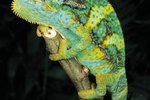
Some types of pet reptile are notorious for living exceptionally long lives. Some tortoises exceed 100 years of age, and snakes like boa constrictors and ball pythons average about 20 years. Chameleons are different, and while there is great diversity within the clade, most have a lifespan measured in years, not decades.
Long-Lived Species
While concrete data on wild lizards and verifiable reports concerning captive specimens are rare, it's clear that the larger species of chameleon live longer than most of the smaller species do. Parson’s (Calumma parsonii), veiled (Chameleo calyptratus) and Oustalet’s (Furcifer oustaleti) chameleons are all large species, known to survive for five to eight years in the wild. In captivity, most have similar or longer lifespans; veiled chameleons are known to live for at least 10 years, and some experts suspect that Parson’s chameleons can reach two decades. Larger species vary in their maturation rate; veiled chameleons mature quickly and can reproduce at 4 to 5 months of age, while most panther chameleons need 12 to 18 months to mature.
Short-Lived Species
At the opposite end of the spectrum, some of the small chameleon species have the some of the shortest lifespans among all vertebrates. The carpet chameleon (Furcifer lateralis), a very colorful species from Madagascar, has a lifespan in the wild of one to two years. Even in the best circumstances, these chameleons rarely live longer than three years. Other species, like Labord’s chameleon (Furcifer labordi), spend eight to nine months incubating underground in their eggs before hatching, growing, maturing and reproducing in as little as four or five months. Shortly after breeding and depositing eggs, all of the adults die. This means that, for much of the year, the only living specimens of this species are found underground, incubating in their eggs.
Common Causes of Premature Death
Many chameleons offered for sale are wild-caught adults. Often, by the time these lizards complete their arduous journey from the forests of Africa to the pet store, they are stressed, dehydrated and have accumulated problematic parasite loads. These lizards have little chance of thriving -- particularly in the hands of an inexperienced keeper. By purchasing captive-bred animals, you can bypass most of these problems. Problems with captive-bred chameleons are most often related to improper lighting, nutrition or both, but advances in husbandry are enabling some captive chameleons to double their wild lifespan.
Maximizing Your Chameleon's Lifespan
To get the most longevity out of your pet chameleon, start with a captive-bred juvenile, and be sure to provide the proper diet, supplementation and UVB levels. Select a larger species that has a 5- to 10-year lifespan, like a panther or veiled chameleon. Realize that males usually live longer than females -- female chameleons often deposit eggs whether they are paired with a male or not. They may lay three or more clutches of eggs per year, each of which is very taxing on her body. Additionally, males are typically, though not always, more boldly colored than females. As pets, males are strongly preferred to females.
Pros and Cons to a Shorter Lifespan
Though a short lifespan is often cited as a negative trait for pets, in many cases a 5- to 10-year commitment is much more appropriate than a half-century commitment. This is especially true with young keepers who don't yet know what their living situation will be in the coming years as they attend college and move out of their parents' homes. It is exceptionally hard to find a find a new home for an unwanted pet reptile, and contrary to popular opinion, most zoos are not interested in adopting your pet lizard.
References
- Smithsonian National Zoological Park: Veiled Chameleon
- San Diego Zoo: Reptiles: Chameleons
- Animal Diversity Web: Furcifer Lateralis
- Zoo Biology: Indoor Husbandry of the Panther Chameleon Chamaeleo [Furcifer] pardalis: Effects of Dietary Vitamins A and D and Ultraviolet Irradiation on Pathology and Life-history Traits
- Proceedings of the National Academy of Sciences of the United States of America: A Unique Life History Among Tetrapods: An Annual Chameleon Living Mostly as an Egg
- Biologic Effects of Light: Ultraviolet Light Requirements of Panther Chameleons in Captivity
- Chameleons! Online Ezine: The Senegal Chameleon, Chamaeleo (Chamaeleo) Senegalensis
- IUCN Red List of Threatened Species: Calumma Parsonii
- Animal Diversity Web: Python regius
- Melissa Kaplan's Herp Care Collection: So You Think You Want a Pet Reptile?
Photo Credits
-
Stockbyte/Stockbyte/Getty Images




